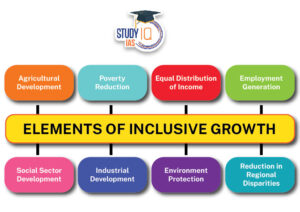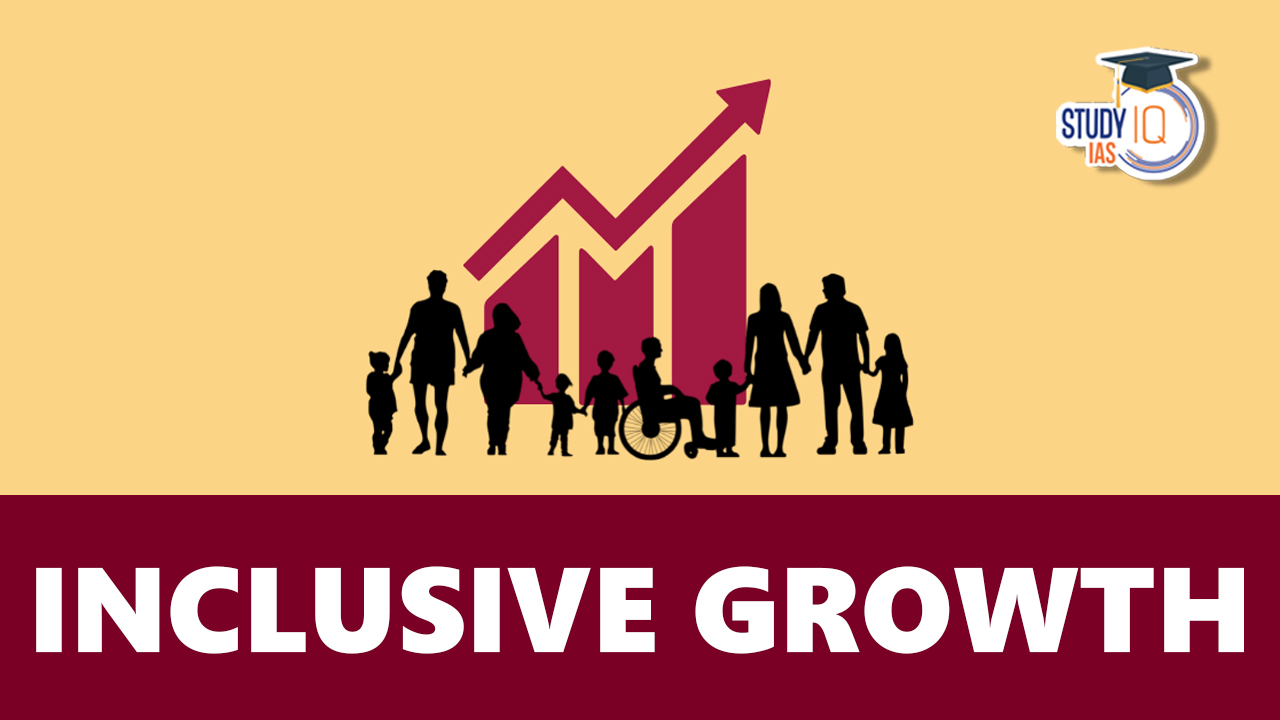Table of Contents
Inclusive Growth
Inclusive growth is a concept used in economics to describe rising living levels among a wide population. From a political standpoint, inclusive growth is crucial since it can have a negative impact on political outcomes if it is not active. Inclusive growth can be defined as economic expansion that lowers poverty and generates a variety of job possibilities. Ensure that everyone has access to the resources and opportunities they need to achieve with the help of inclusive growth initiatives.
Inclusive Growth Introduction
Inclusive growth is described by the UNDP as “the process and result of all groups of people participating in the organisation of growth and benefiting equitably from it.” This indicates that if all societal segments are included as beneficiaries, growth can be seen as inclusive.
A society can be said to be growing inclusively if it offers all of its members the best possible means of subsistence and employment. Access to essential services, such as decent health, quality education, equal employment opportunities, and the empowerment of women via education and skill development, is offered to those who benefit from inclusive growth.
The OECD defines inclusive growth as economic growth that offers opportunities for all people and is dispersed equally across society. Environmentally friendly growth and effective governance are constantly prioritized by inclusive growth in order to foster the emergence of a gender-sensitive society.
Inclusive Growth Elements
It is crucial to recognise and comprehend the critical components that contribute to inclusive growth in order to attain it. We will examine some of the key components of inclusive growth and their significance in fostering social development that is sustainable.

Skill Development: One component of inclusive growth is skill development. The economic survey indicates that in 2017, more than 31% of you in India were not enrolled in any type of training, work, or education. In reality, according to a UNICEF survey, more than 45% of young people in India are not interested in obtaining the kind of education and job-related skills they need. It is reasonable to assume that India faces difficulties in ensuring the right skill development of its workforce due to the lack of highly skilled people and the difficulty in offering employment chances for workers with conventional training.
Financial inclusion: For all people, including those in vulnerable groups, it means affordable access to financial aid and services. Financial inclusion is essential for economic development and inclusive growth.
Technological Development: The advancement of technology is another component of inclusive growth. We are entering the industrial revolution age right now. When it comes to technology, we have choices. Technology developments have the potential to either increase or alleviate inequality. Depending on how it is used, yes. The Indian government has undertaken a number of initiatives.
Digital India Mission: One of these is the population that is digitally educated, which will be able to use the economy to take advantage of fewer chances as a result of the quest for a digital India. The goal of the Digital India mission is to increase people’s digital literacy so they can take full advantage of technology.
Agriculture: The use of contemporary technologies in agriculture will greatly aid farmers in the production of high-quality crops. By creating employment opportunities and raising the income of rural residents, agriculture may play a significant role in attaining inclusive growth.
Education: With the introduction of digital education, students are becoming accustomed to technology in their early years of schooling, such as laptops and smart boards, which will aid them in understanding the technology quickly. Technology development is hastening the transformation of India’s educational system.
Poverty Reduction: The proportion of the population living below the official poverty line declined from 21.9% to 21.9% between 1993 and 2011. A tiny number of groups still experience a high prevalence of poverty, and this number has hardly changed at all. Additionally, the rate of poverty reduction has not accelerated up with GDP expansion. It is intolerable that there is still so widespread poverty.
In order to considerably reduce poverty and expand economic prospects for all groups of the population, it should be a central goal of the New India vision. Rapid economic development is required to achieve this goal because it is a means of increasing employment and incomes for many of our people. The distribution of economic growth among regions has not been uniform, and some of the least developed areas have not yet experienced significant growth.
Employment Generation: To achieve inclusive growth in India, employment generation is necessary. Despite the fact that half of India’s population is under the age of 26, not enough new economic possibilities are being generated to meet the rising demand for jobs. India needs 12–15 million new workers per year, leaving 4–7 million open posts, according to estimates. Things only become worse because there are 300 million people of working age who are not employed. As a result, creating jobs will not only increase GDP (via fiscal stimulus), but also create a workforce that is fit and competent for the future.
Social Development: The marginalized groups, such as the SC, ST, OBC, women, and transgender, are included when discussing technology in terms of social development, and it gives them the best technological possibilities for learning new things. New schools, universities, and different social institutions like hospitals and workplaces can be built to give them enough room to work.
Inclusive Growth and Challenges Associated
Poverty
Between 2005–2006 and 2015–16, 271 million people in India were lifted out of poverty, according to the 2018 Multidimensional Poverty Index (MPI), with the poorest areas, populations, and kids enjoying the biggest declines. The most blatantly pro-poor tendency may be seen at the subnational level in India. Despite the great progress, 373 million Indians still live in extreme poverty. Additionally, 19.3% of the population is at risk of multidimensional poverty, while 8.8% of people live in severe multidimensional poverty.
Unemployment
According to the Periodic Labour Force Survey (PLFS) conducted by the NSSO, the unemployment rate in urban areas was 7.8%, while the rate in rural areas was 5.3%, bringing the overall rate to 6.1 percent. India has low employment quality and quantity due to illiteracy and an overreliance on agriculture. Because more than 80% of people work in the unorganized sector and are not protected by social security, the lack of quality employment is an issue.
Agriculture Backwardness
Even while it only contributes 16.5 percent of the nation’s GDP, agriculture employs nearly 44 percent of Indians, which leads to a high level of poverty. The issues in agriculture include some of the following:
- The amount of land per person is decreasing.
- A progressively falling employment share.
- There is low labour productivity.
- As a result of soil erosion, climate change, and water scarcity, agricultural yields are decreasing.
- Variations in crop and region growth
Issues with Social Development
Social development is one of the most crucial issues for inclusive growth. It has certain problems, such:
- There are considerable regional, cultural, and gender variances.
- Public spending is modest and expanding slowly, especially in the areas of health and education.
- The inadequate calibre of the delivery system.
- Muslims, OBCs, SCs, and STs have much lower social indicators.
Child malnourishment – India is rated 102nd in the world for hunger
Regional Disparities
Regional variations in India are a major source of worry. Regional disparities are caused by a number of factors, including the caste system, the income divide, and others, and as a result, some groups in society are more privileged than others. The following are a few problems with geographic disparity:
- Bihar has a literacy rate of only 63.82 percent, whereas Kerala has the highest literacy rate in the nation at 93.1 percent.
- Goa has a per capita income of Rs. 4,67,998, while the per capita income in Bihar is only Rs. 43,822.
Measures to Achieve Inclusive Growth
India has made considerable strides in recent years towards achieving economic growth as a developing country, but there is still a significant imbalance in the distribution of wealth and resources. The Indian government has implemented a number of policies targeted at fostering inclusive growth in order to overcome this difficulty. Below, we’ve listed the primary steps the government has done to ensure inclusive growth.
- Prime Minister Employment Generation program
- National Health Mission
- Bharat Nirman
- Mission Ayushman
- Sarv Shiksha Abhiyan
- National Urban Livelihood Mission
- The government is actively working with Non-governmental Organizations and International groupings in policy-making to achieve Inclusive Growth. Projects like DISHA are being implemented. DISHA is being implemented in partnership with the UNDP with the aim of creating entrepreneurial opportunities and employment.
- NITI Aayog has started working on the Strategy for New India@75, which has the following objectives for Inclusive Growth
- Rapid growth (9-10% by 2022-23) that is inclusive, sustainable, and clean.
Inclusive Growth Measures Taken in India
The government is implementing a number of measures to promote equitable growth, including the following:
- Mahatma Gandhi National Rural Employment Guarantee Act Scheme (MGNREGA)
- Prime Minister’s Employment Generation Programme (PMEGP)
- Mudra Bank scheme
- Deen Dayal Upadhyaya Grameen Kaushalya Yojana (DDU-GKY)
- Deendayal Antyodaya Yojana- National Urban Livelihoods Mission (DAY-NULM)
- Sarva Siksha Abhiyan (SSA)
- National Rural Health Mission (NRHM)
- Bharat Nirman
- Swachh Bharat Mission
- Mission Ayushman
- Pradhan Mantri Jan Dhan Yojana
Inclusive Growth UPSC
Consequently, inclusive economic growth is crucial for sustainability. Maintaining this might be difficult since economic development can have undesirable effects, such as a rise in corruption, a major problem in emerging countries. However, the secret to efficient growth is to prioritise inclusivity, particularly on equality of opportunity in terms of access to markets, resources, and a fair regulatory environment.


 Nilgiri Biosphere Reserve, Map, Climate,...
Nilgiri Biosphere Reserve, Map, Climate,...
 Repo Rate and Reverse Repo Rate, Impact ...
Repo Rate and Reverse Repo Rate, Impact ...
 Foreign Contribution Regulation Act (FCR...
Foreign Contribution Regulation Act (FCR...





















